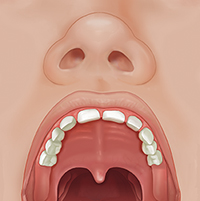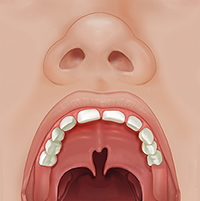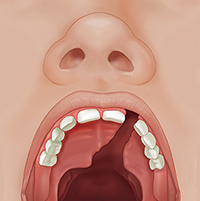When Your Child Has a Cleft Palate
When Your Child Has a Cleft Palate
Your infant may look different than you had expected. You may be feeling shocked, confused, or worried. You are not alone. In fact, many children are born with a cleft palate (roof of the mouth), cleft lip, or both. In the U.S., about 1 out of every 1,500 babies is born with a cleft palate. Your baby’s palate can be repaired so the mouth looks and works normally.
Normal palate |
Partial cleft palate |
Complete cleft palate |
What is a cleft palate?
The word cleft means “split” or “separation.” Your child’s palate is separated because it didn’t form properly as your child developed in the womb. A cleft palate can lead to some challenges, but these challenges can be managed. Once treated, a cleft palate usually does not cause long-term problems.
What causes a cleft palate?
You may be worried that you did something to cause your child’s cleft palate. The truth is that it is not known why some children’s palates don't form normally in the womb. It is known that it’s not your fault or the fault of your healthcare provider. Certain factors may make a cleft palate more likely to occur in some children. One of these is family history. If you or someone in your family was born with a cleft palate, cleft lip, or both, your children may be more likely to have a cleft at birth. Your healthcare provider can discuss with you any factors that may have led to the cleft palate.
How is a cleft palate treated?
A cleft palate is repaired with surgeries. The first surgery is done when your child is around 9 to 18 months old. A number of surgeries may be needed to repair the palate so that it looks and functions like normal. Your child’s doctor will discuss the surgery plan with you.
Until the cleft palate is fixed, your baby may need to use an artificial (prosthetic) palate. This will fill in the cleft to make it easier for your baby to eat. In the meantime, you will be shown how to care for your new baby.
Who will help me care for my baby?
Always remember that you are not alone. A team of specialists will help you care for your child. This team will include some or all of these key members:
Plastic or reconstructive surgeon. A doctor who repairs areas of the body so they appear and function more normally. He or she may do the surgery to repair the cleft palate.
Otolaryngologist. A doctor who specializes in the health of the mouth, nose, and ears (also called an ENT doctor). In some cases, surgery to repair the cleft palate may be done by the ENT doctor.
Genetic specialist. A provider who helps determine whether the cleft palate is a genetic (passed down) condition. This helps you know whether children you have in the future are more likely to have a cleft palate, cleft lip, or both. He or she can also diagnose any genetic syndromes or conditions related to cleft palate.
Audiologist. A specialist who tests for and diagnoses hearing problems. He or she also helps find solutions to manage any hearing loss.
Speech pathologist, occupational therapist, or both. These are professionals who identify and treat speech, language, and swallowing problems. They may also discuss feeding issues with you. These often occur along with cleft palate.
Psychologist or social worker. A specialist who helps your child and family cope with emotional, social, and financial issues that may arise with cleft palate.
Primary healthcare provider. A doctor or other healthcare provider who specializes in the general health needs of patients.
Nurses. Healthcare professionals who care for your child in the hospital before, during, and after surgery. Nurses also help with any feeding issues.
Caring for a child with a cleft palate
A child born with a cleft palate has the same needs as other newborns. But meeting these needs can be challenging at times. Have patience as you find the best way to care for your baby. Some challenges of caring for a baby with a cleft palate may include:
Feeding. Depending on the type and shape of the cleft palate, it may be hard for your baby to eat. Milk may go into the nose. This can cause choking. Special nipples and bottles are available that can help. Your nurse, occupational therapist, or lactation specialist will help you figure out what works best for your baby. They may also help with feeding issues. You won’t be sent home from the hospital until your baby is feeding well and is gaining weight.
Hearing. Ear problems, such as ear infections and temporary hearing loss, are more common in children with cleft palates than in other children. An audiologist will check your child’s hearing as he or she grows. Fluid buildup in the ears is a common cause of temporary hearing loss in children with cleft palate. Tiny tubes to help drain this fluid may need to be inserted into your child’s eardrums. This is often done at the time of the cleft palate surgery. Your child’s ENT doctor will talk to you about this.
Speech. Cleft palate can make speaking difficult. The child’s voice may have a nasal quality and be hard to understand. Making certain sounds, such as consonants (for example, “s” and “t” sounds), can be hard with a cleft palate. This occurs because the opening in the palate allows air to escape through the nose. A speech pathologist will work with your child to help your child learn to speak properly.
Dental. If the cleft affects the gum or hard palate, your child may need surgery to help line up the teeth. Your child’s dentist or orthodontist will begin working with your child as soon as possible to ensure proper health and alignment of the teeth.
Appearance. Talk with siblings, other family members, and friends about your baby’s cleft palate before you introduce the baby. This helps create sensitivity about your baby’s condition.
Coping
You may wonder how you’ll be able to care for your new baby. This is normal. Remember that your child’s cleft palate can be repaired. And, most importantly, remember that your child needs to be loved, touched, and comforted. Support groups are available so you can talk with other parents of children with cleft palates.
Learning more
If you have questions, talk to your child’s care team. Also, look in your local library or bookstore for books about cleft-affected children. These online resources can also be helpful:
American Cleft Palate-Craniofacial Association, www.acpa-cpf.org
American Society of Plastic Surgeons, www.plasticsurgery.org/Reconstructive-Procedures/Cleft-Lip-and-Palate.html
Cleft Palate Foundation, www.cleftline.org
Financial concerns
In the U.S., cleft palate repair is usually covered by private insurance or as part of a state or federal program, such as Medicaid. Other programs can also help pay for surgery and related expenses. Talk to your social worker about any financial concerns you have about the care of your child.
Updated:
August 10, 2018
Reviewed By:
Bass, Pat F III, MD, MPH,Image reviewed by StayWell medical illustration team.,Kacker, Ashutosh, MD


